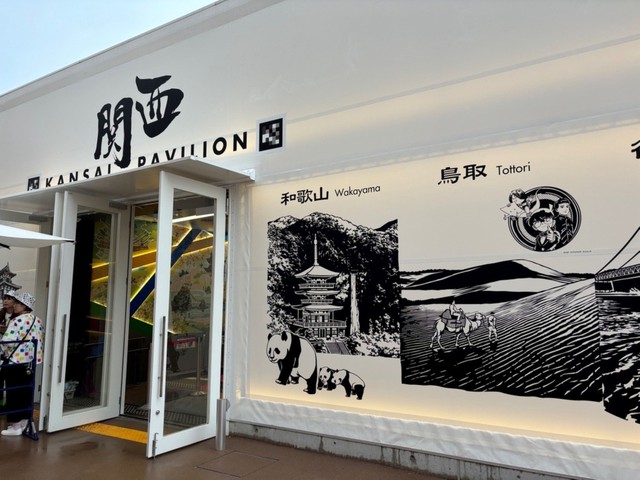
The facade of the Kansai Pavilion at the Osaka Expo, decorated with paper cutouts of signature Kansai landscapes. Photo: Jiji Press
The Kansai Pavilion offers numerous experiences to allow visitors to understand the rich history and culture of the region, according to the Osaka Expo's official guidebook.
In contrast, the Osaka Healthcare Pavilion, another Kansai-related pavilion, exhibits futuristic products by local manufacturers.
Takeo Mori, secretary-general of the Kansai Pavilion, emphasized the coexistence of diversity and unity particular to the region.
"Under the slogan 'Diverse Kansai and One Kansai,' we are all here to help visitors learn how attractive the Kansai region is," he said, noting that local people are enjoying running the pavilion themselves.
Local appeal
Since the Expo opened on April 13, the Kansai Pavilion has been welcoming guests with booths for eight prefectures in the greater Kansai region showcasing the history, regional products, tourism and cultural resources of each area.
Among them, Mie Prefecture features its local specialties in several pull-out drawers set up on the walls of its booth, filled with a variety of local items including a life-sized model of the Japanese giant salamander, which lives in the prefecture's Iga area, and pearls cultured in the Ise-Shima district.
Some displays in the drawers appeal to the senses of visitors, allowing them to smell the scent of sake brewed in the Hokusei area, for example.
"Our booth has a concierge to offer guidance to Expo visitors on recommended places to travel in Mie," said Kyoka Morikawa of the Mie booth. "We hope people will explore the rich history and culture of Mie at first hand."
Noting that some staff at the Mie booth are from other parts of Kansai, Morikawa said that they are there to show guests that "their love for Mie" is as strong as that of people from the prefecture.
Although in the same pavilion, the prefectures use their own ways to promote themselves.
Fukui Prefecture, which is known as a leading area for dinosaur fossil discoveries, offers the experience of a simulated excavation of dinosaur fossils as well as virtual-reality travel through the rise and fall of the dinosaurs.
Meanwhile, Hyogo Prefecture has a theater called the "Mirai (future) Bus," which shows "passengers" the past, present and future of the prefecture via a bus ride of the imagination.
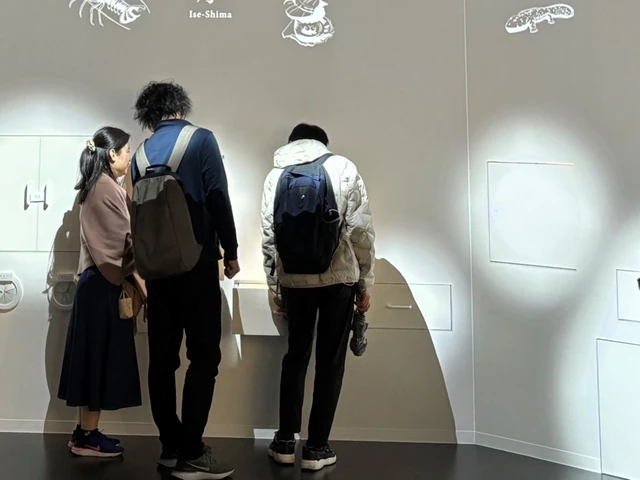
Visitors explore products from Mie Prefecture by opening drawers built into the walls of the Kansai Pavilion's Mie booth at the Osaka Expo. Photo: Jiji Press
Discovering charms
Many locals are among the visitors packing out the Kansai Pavilion.
Kazumi Yoshimura, 63, a nurse from Kyoto Prefecture in Kansai, discovered many sites to visit in the region.
"By learning about the charms of Kansai at this pavilion, I realized I'd passed many attractive places by car and train without noticing," she said.
Junior high school students from Osaka enjoyed the Tokushima Prefecture booth.
"We practiced Awa Odori traditional local dance at the booth, and it was fun," one of the students said with a smile. "We're already looking forward to coming back in this year's summer holidays."
For foreigners who are less familiar with Kansai, the pavilion serves to help deepen their understanding of the region.
Souad El Fenni, a 29 years-old graphic designer from Paris, stayed at the pavilion for three hours, reflecting her strong interest in Japanese culture.
"The immersive experiences are mesmerizing, especially a projection mapping on sand at the booth of Tottori Prefecture," known for the Tottori Sand Dunes, she said.
Despite the popularity in France of Japanese animation 'Detective Conan,' one of the icons used to promote the booth, Fenni did not know its author, Gosho Aoyama, is from Tottori.
"From the experience at the pavilion, I found that Tottori is a very interesting place," she added.
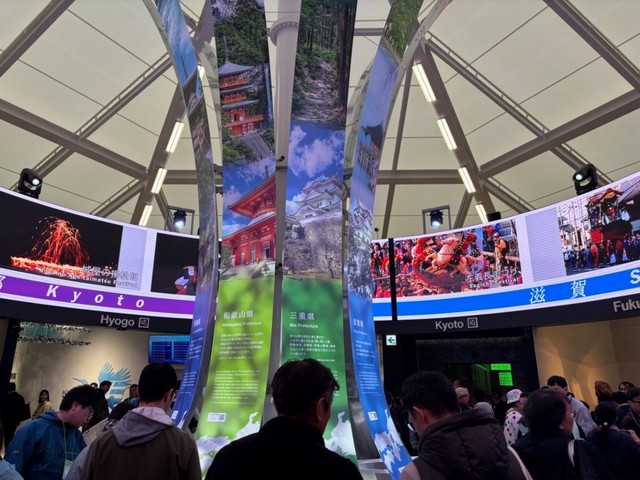
The crowded center circle of the Kansai Pavilion at the Osaka Expo, featuring new photos and videos from the prefectures represented in the Pavilion. Photo: Jiji Press
Tradition of sustainability
Although the Kansai Pavilion does not have a permanent shop, visitors can buy souvenirs at the nearby Okoshiyasu Kyonokomichi shop, which introduces Kyoto Prefecture's traditional techniques and flavors, such as lacquerware and "tsukemono" Japanese pickles.
The shop not only sells products from the prefecture, one of the most famous tourist spots in Kansai, but also offers customers unused "furoshiki" traditional wrapping cloths that were donated by Kyoto locals.
After shopping, customers can purchase furoshiki for use as reusable bags to carry the souvenirs they bought at the shop.
The shop staff's uniforms are made from upcycled kimono traditional Japanese attire.
"People in Kyoto has been upcycling things in their daily lives, so we're eager to introduce a sustainable way of living from Kyoto to Expo visitors," Yoshio Oi, assistant manager of the shop, said.
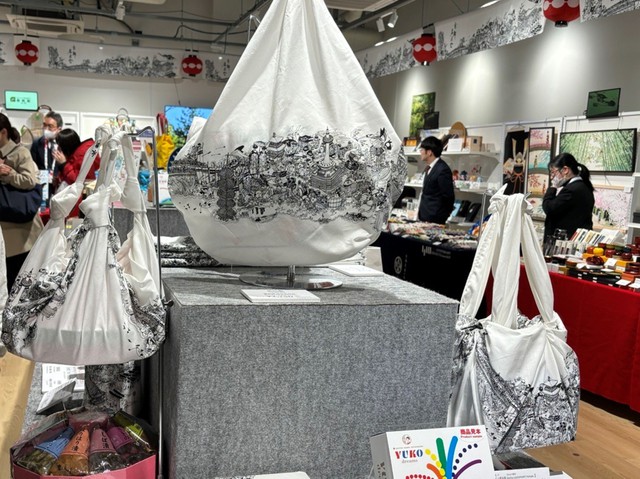
Traditional "furoshiki" wrapping cloths on display at the Okoshiyasu Kyonokomichi Kyoto souvenir shop at the Osaka Expo. Photo: Jiji Press
Yosuke Honda, a 45-year-old company worker from Osaka, entered the shop with his wife to escape the rain and bought a bottle of sake.
"If the Expo had not been held in Kansai, I might not have visited the site and learned about this sake," he added.
Carlos Castellon, 46, a doctor from Spain, came to the Expo as part of a three-week trip across Japan.
Castellon and his partner, Leili Huth, a 35-year-old art collector, bought many Kyoto products at the shop, including a pouch made with "Nishijin-ori" textile. They enjoyed the staff's "very Japanese hospitality" to teach them how to wrap items with furoshiki.
Away from the Expo's futuristic image, this year's event aims to allow visitors to feel the strong links between the prefectures of Kansai.
"The lively atmosphere of the Expo is created by the sense of camaraderie among people in Kansai, as well as the momentum we generate to attract people from all over the world to the region," Mori of the Kansai Pavilion said.
"We hope people will see and enjoy Kansai, which is as diverse but cohesive as 'osechi,'" a wide variety of traditional Japanese New Year foods served in the same box.


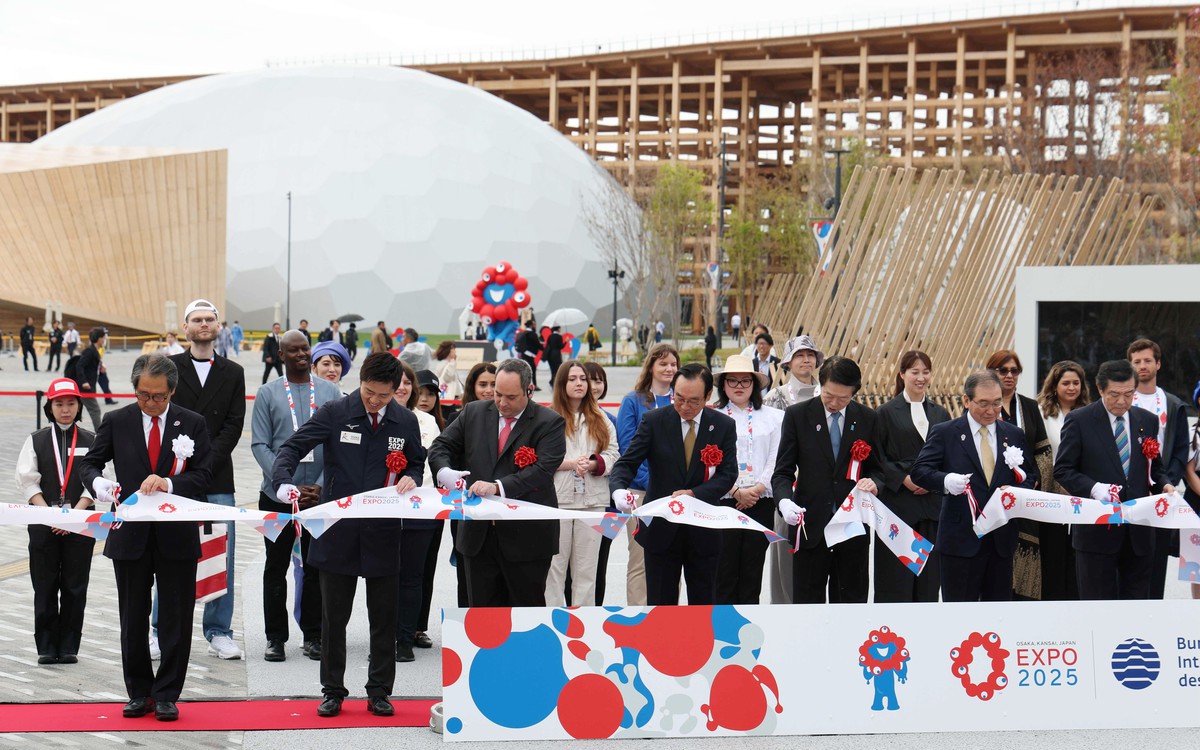
Max: 1500 characters
There are no comments yet. Be the first to comment.